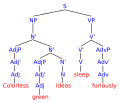article describes the syntax and semantics of the purely declarative subset of these languages. Confusingly, the name "logic programming" also refers to a...
18 KB (2,189 words) - 10:07, 12 February 2024
strings in a programming language syntax. It is closely related to, and often crosses over with, the semantics of mathematical proofs. Semantics describes...
18 KB (1,671 words) - 06:21, 19 July 2024
logic, syntax is anything having to do with formal languages or formal systems without regard to any interpretation or meaning given to them. Syntax is...
10 KB (1,004 words) - 15:12, 23 March 2024
Logic programming is a programming, database and knowledge representation paradigm based on formal logic. A logic program is a set of sentences in logical...
84 KB (10,723 words) - 18:49, 8 May 2024
In logic, the semantics of logic or formal semantics is the study of the semantics, or interpretations, of formal languages and (idealizations of) natural...
5 KB (574 words) - 15:20, 23 March 2024
Disjunctive Datalog (category Logic programming languages)
model semantics. Syntax and semantics of logic programming Kaminski, Mark; Nenov, Yavor; Grau, Bernardo Cuenca (2014-06-21). "Datalog Rewritability of Disjunctive...
3 KB (360 words) - 04:32, 21 April 2024
The syntax and semantics of Prolog, a programming language, are the sets of rules that define how a Prolog program is written and how it is interpreted...
15 KB (1,964 words) - 23:36, 11 June 2023
variation, and the relationship between form and meaning (semantics). There are numerous approaches to syntax that differ in their central assumptions and goals...
25 KB (2,777 words) - 13:45, 30 July 2024
The syntax of the Python programming language is the set of rules that defines how a Python program will be written and interpreted (by both the runtime...
59 KB (6,790 words) - 20:26, 13 May 2024
denotational semantics. In 1972, logic programming and Prolog were developed thus allowing computer programs to be expressed as mathematical logic. A team of scientists...
15 KB (1,618 words) - 10:45, 11 June 2024
programming language is a system of notation for writing computer programs. Programming languages are described in terms of their syntax (form) and semantics...
71 KB (8,045 words) - 09:12, 5 August 2024
Formal semantics relies on logic and mathematics to provide precise frameworks of the relation between language and meaning. Cognitive semantics examines...
133 KB (14,259 words) - 05:00, 13 July 2024
Formal system (redirect from System of logic)
definition, 2007. Daniel Richardson, Formal systems, logic and semantics William J. Rapaport, Syntax & Semantics of Formal Systems PlanetMath, Formal System Pr∞fWiki...
14 KB (1,534 words) - 21:31, 10 May 2024
λProlog (a logic programming language featuring polymorphic typing, modular programming, and higher-order programming) Oz, and Mozart Programming System cross-platform...
91 KB (6,911 words) - 23:50, 7 August 2024
Reference Semantics Strict conditional Syntax (logic) Truth Truth value Validity Affine logic Alethic logic Aristotelian logic Boolean logic Buddhist logic Bunched...
24 KB (2,084 words) - 23:23, 8 July 2024
declarative programming is a programming paradigm—a style of building the structure and elements of computer programs—that expresses the logic of a computation...
23 KB (2,376 words) - 21:08, 31 July 2024
In semantics, mathematical logic and related disciplines, the principle of compositionality is the principle that the meaning of a complex expression...
13 KB (1,404 words) - 22:02, 31 March 2024
additional quantifiers and, sometimes, stronger semantics. Higher-order logics with their standard semantics are more expressive, but their model-theoretic...
9 KB (1,061 words) - 10:50, 5 December 2023
classical logic. The standard explanation of intuitionistic logic is the BHK interpretation. Several systems of semantics for intuitionistic logic have been...
51 KB (7,745 words) - 17:38, 4 August 2024
Web Ontology Language (category Declarative programming languages)
structure and semantics. The OWL abstract syntax presents an ontology as a sequence of annotations, axioms and facts. Annotations carry machine and human...
41 KB (4,120 words) - 09:00, 31 July 2024
programming languages follow rules for syntax and semantics. There are thousands of programming languages and new ones are created every year. Few languages...
70 KB (1,469 words) - 03:20, 31 July 2024
theory of such logics was almost non-existent before Kripke (algebraic semantics existed, but were considered 'syntax in disguise'). The language of propositional...
34 KB (4,751 words) - 13:41, 28 February 2024
A VPL allows programming with visual expressions, spatial arrangements of text and graphic symbols, used either as elements of syntax or secondary notation...
29 KB (3,271 words) - 06:53, 15 August 2024
p then q" and another in the form "p", and returns the conclusion "q". The rule is valid with respect to the semantics of classical logic (as well as...
11 KB (1,470 words) - 00:13, 15 August 2024
Formal language (redirect from Language (logic))
In logic, mathematics, computer science, and linguistics, a formal language consists of words whose letters are taken from an alphabet and are well-formed...
27 KB (3,070 words) - 06:31, 13 July 2024
denotational semantics (initially known as mathematical semantics or Scott–Strachey semantics) is an approach of formalizing the meanings of programming languages...
32 KB (3,769 words) - 17:52, 14 August 2024
of first-order logic. The syntax determines which finite sequences of symbols are well-formed expressions in first-order logic, while the semantics determines...
93 KB (13,105 words) - 06:25, 9 August 2024
Actor model (redirect from List of actor programming languages)
logic programming has been integrated into the actor model in a way that maintains logical semantics. Migration in the actor model is the ability of actors...
80 KB (7,146 words) - 18:54, 29 May 2024
comparison, a high-level programming language isolates execution semantics of a computer architecture from the specification of the program, which simplifies...
13 KB (1,583 words) - 23:14, 23 July 2024
programming languages. The most important feature of QCL is the support for user-defined operators and functions. Its syntax resembles the syntax of the...
41 KB (4,217 words) - 07:48, 15 August 2024







